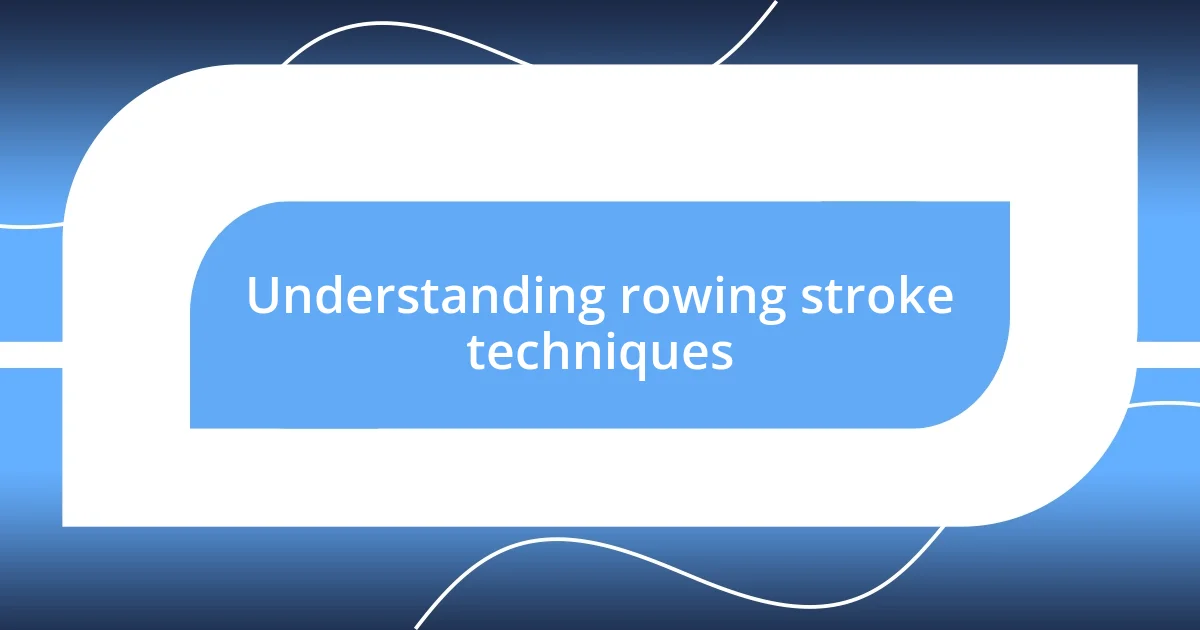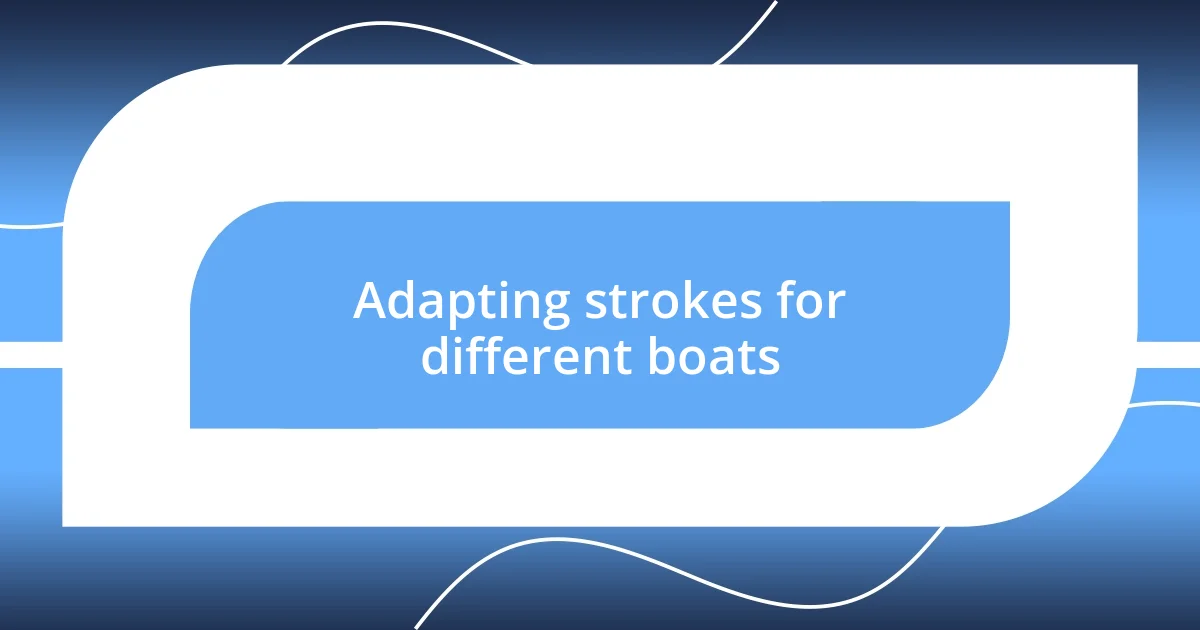Key takeaways:
- Mastering the catch and finish strokes enhances overall rowing efficiency, emphasizing light entry and strong follow-through.
- Stroke variations are influenced by personal fitness, boat type, and environmental conditions, necessitating adaptability in technique.
- Personalizing techniques, maintaining rhythm, and utilizing feedback improve stroke efficiency and connection with the boat.

Understanding rowing stroke techniques
Rowing stroke techniques are truly a blend of precision and rhythm. I remember my first time on the water, feeling overwhelmed by the coordination required to synchronize my body, arms, and legs. Have you ever felt like you were fighting against the boat instead of moving with it? It took practice to learn how each part of my body contributes to an effective stroke, turning that initial struggle into fluid movement.
One of the critical components of a good rowing stroke is the catch. I still recall that exhilarating moment when I finally nailed the perfect catch. It felt like the boat glided forward effortlessly as I engaged my core and legs simultaneously. If you focus on entering the water with a light touch, you’ll find it easier to build speed without wasting energy. This technique not only enhances efficiency but also brings a sense of harmony to the act of rowing.
Another important aspect is the finish, where the stroke culminates. I used to neglect this part, thinking it was merely a follow-through. But when I started to concentrate on my hand’s placement by my chest and the release of the oar, it transformed my performance. Have you noticed how a strong finish gives you that final kick of power? Engaging in this detail can make all the difference, providing you with a feeling of accomplishment as the boat surges forward.

Factors influencing stroke variations
Stroke variations in rowing can be influenced by several factors, including personal fitness levels, boat type, and environmental conditions. For instance, I’ve noticed that on days when I’m feeling particularly strong, I naturally gravitate towards a more powerful stroke. In contrast, when I’m fatigued, I tend to focus on quicker, lighter strokes that require less energy but still maintain speed. Have you ever felt that shift in rhythm when conditions change?
Boat type also plays a significant role. I remember my first experience in a scull, where the narrow design demanded a different stroke technique than what I was used to in a wider crew boat. The moment I adjusted to a more delicate and precise pull, I could feel the boat responding more smoothly through the water. It’s fascinating how the subtle changes in equipment can require us to rethink and adapt our techniques.
Environmental conditions, such as wind and water current, can further shape stroke variations. For example, I once faced a challenging day where a strong headwind forced me to change my approach, focusing on powerful strokes to cut through resistance. This experience underscored how an understanding of external elements can equip us with the flexibility needed to adjust our rowing style effectively.
| Factor | Influence on Stroke |
|---|---|
| Personal Fitness | Stronger fitness leads to powerful, longer strokes; fatigue switches to quicker, lighter strokes. |
| Boat Type | Different boats necessitate adjustments in stroke technique for optimal performance. |
| Environmental Conditions | Wind and current can alter stroke power and rhythm, requiring adaptability. |

Types of rowing strokes explained
Understanding the different rowing strokes can significantly enhance your performance on the water. Each stroke offers a unique way to engage your body and adapt your technique to different scenarios. I remember experimenting with the feathered stroke during a windy day, and the sensation was both exhilarating and liberating. It allowed me greater control of my oar with every pull, especially when navigating through choppy waters. Sometimes, it’s all about finding that sweet spot between strength and technique.
Here’s a breakdown of common rowing strokes:
- Catch Stroke: Where the blade enters the water. I find that a light touch here can make all the difference.
- Drive Stroke: This is where the power happens, utilizing your legs and core. It’s an invigorating moment when it feels like the boat surges forward beneath you.
- Finish Stroke: The last part of the stroke, which I used to overlook. When I learned to emphasize a strong finish, it became my favorite moment – a true celebration of effort.
- Recovery Stroke: This is the transition back to the catch. I often remind myself to stay relaxed, as this phase allows me to regain energy for the next stroke.
By exploring these variations, you’ll develop a more nuanced approach to your rowing practice, tailoring each stroke to your needs and conditions.

Common rowing stroke mistakes
Many rowers overlook the importance of body position, which can lead to some common mistakes. I remember when I first started rowing; I often hunched over my oar, thinking it would generate more power. Instead, it caused unnecessary strain on my back and ultimately slowed me down. Have you ever found yourself in a position that felt comfortable but didn’t serve you well? It’s crucial to maintain an upright posture to harness the full power of your legs and core effectively.
Another frequent error is rushing through the recovery phase. In my early days, I was so eager to push through the drive that I would barely take a breath before the next stroke. This eagerness not only slowed my overall pace but also increased my fatigue. I’ve learned that a deliberate recovery allows for better rhythm and energy conservation, ultimately improving my performance. How often do you allow yourself to settle into the rhythm of the water before diving back into the next stroke?
Lastly, synchronization with your crew is vital. I can’t recall the number of times I found myself out of sync during team sessions, leading to wonky strokes and frustrating splashes. It was only when we focused on timing and communication that we started to glide seamlessly across the water. Rowing can be a beautiful dance when everyone moves in harmony, so consider the power of synchronization in your outings. How do you synchronize with those around you?

Adapting strokes for different boats
Adapting your stroke for different boats is crucial for maximizing efficiency and performance. I’ve found that when I switch from a single scull to a quad, I need to refine my stroke timing significantly. In a single, each pull feels personal and powerful, but in a quad, it’s almost like learning a dance – the rhythm of the crew transforms how I engage with each stroke. Have you ever experienced the thrill of that synchronized flow? It’s something special.
When I transitioned to a racing shell, I realized that my catch stroke had to be sharper and more explosive. In contrast, I found a smoother, more gradual stroke works better in a heavier boat, like an eight. This adjustment not only conserves energy but also ensures better boat balance. I remember one particularly tricky practice where we struggled against the current; it taught me that adapting my technique to fit the boat’s characteristics can truly make or break a session.
Have you ever noticed how different boats respond to your effort? I certainly have. For instance, in lighter crafts, maintaining a high stroke rate feels like flying, but in a more robust boat, finding a rhythm that’s sustainable is key. I’ll never forget the moment I shifted my focus from sheer power to efficiency in the heavier boat – it felt like I finally unlocked the secret to smooth gliding. Each boat tells its own story, and adapting your stroke helps you embrace that narrative fully.

Personalizing your rowing technique
Personalizing your rowing technique is all about finding what works best for you. I vividly recall my days experimenting with my grip and hand positioning. At first, I didn’t think much of it, but when I shifted my hands closer together, I felt a boost in control and power. Have you ever adjusted something simple but found it made a big difference? It truly can alter your entire experience on the water.
Another aspect to consider is your stroke rhythm and power application. I remember a session where I consciously slowed down my stroke rate. Surprisingly, I maintained speed and felt less fatigued afterward. I realized that sometimes we get caught up in the idea that faster is always better. What if taking a step back and focusing on quality over speed could enhance your overall performance? That shift in mindset made me more aware of how I connected with the boat.
Lastly, it’s essential to incorporate feedback from your body and crew. I learned this the hard way during a regatta; after a particularly tough heat, I was sore in ways I hadn’t anticipated. Listening to my body led me to adjust my posture and driving technique for better alignment and endurance. How often do you stop and assess what your body is telling you? I find that reflection is just as important as training techniques, and it fosters a deep connection with my rowing journey.

Improving your stroke efficiency
Improving your stroke efficiency can be a transformative experience, and I often reflect on my training sessions to pinpoint what truly makes a difference. There was a time when I focused solely on strength, thinking that it would make my strokes more powerful. But it wasn’t until I learned to engage my core more effectively that I noticed how much smoother and more controlled my strokes became. Have you ever experienced that shift from raw power to a well-timed rhythm? It can feel like a revelation.
I also remember an insightful conversation with my coach about the importance of maintaining a consistent tempo throughout the stroke. One day, during practice, I decided to consciously work on keeping my hands moving fluidly and at the same speed through the water. I was amazed at how this minor adjustment not only kept my energy up but also allowed me to glide effortlessly. Doesn’t it feel incredible when small tweaks lead to significant improvements? I found a newfound sense of connection between my body and the boat, and it was a breakthrough moment.
Lastly, I’ve learned that incorporating video analysis significantly enhances stroke efficiency. After reviewing footage from my training, I spotted areas where my arm angle was off balance. Seeing it visually made all the difference! Have you ever considered how valuable it is to witness your technique and identify opportunities for improvement? That experience underscored the fact that stroke efficiency isn’t just about physical strength; it’s also about aligning your movements with perfect form. Each small insight can lead to a more fluid experience on the water.














